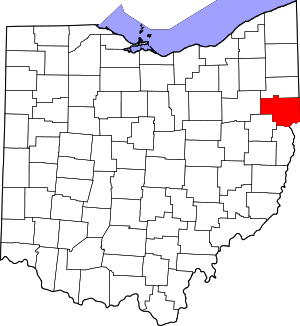Wellsville, Ohio
Wellsville is a village in Columbiana County, Ohio, United States, along the Ohio River. The population was 3,541 at the 2010 census.[5] Wellsville is the southernmost point of the Salem, OH Micropolitan Statistical Area, as well as the greater Mahoning Valley.
Wellsville, Ohio | |
|---|---|
| Village of Wellsville | |
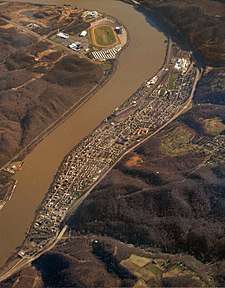 Wellsville from the air, looking south. The Mountaineer Casino, Racetrack and Resort is visible towards the top. | |
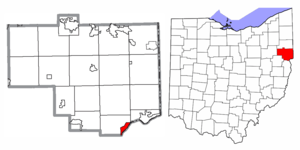 Location of Wellsville in Columbiana County and in the State of Ohio | |
| Coordinates: 40°36′15″N 80°39′8″W | |
| Country | United States |
| State | Ohio |
| County | Columbiana |
| Government | |
| • Type | Council-Manager |
| • Mayor | Nancy Murray (D)[1] |
| • Village Administrator | Marcus Dalrymple |
| Area | |
| • Total | 1.91 sq mi (4.95 km2) |
| • Land | 1.80 sq mi (4.67 km2) |
| • Water | 0.11 sq mi (0.28 km2) |
| Population | |
| • Total | 3,541 |
| • Estimate (2019)[4] | 3,306 |
| • Density | 1,834.63/sq mi (708.37/km2) |
| Time zone | UTC-5 (Eastern (EST)) |
| • Summer (DST) | UTC-4 (EDT) |
| ZIP code | 43968 |
| Area code(s) | 330, 234 |
| FIPS code | 39-82740 |
| School District | Wellsville Local |
| Website | http://www.wellsvilleohio.us/ |
History
Colonial era
In 1770, George Washington with his friend and personal surveyor, William Crawford, embarked on a journey down the Ohio River from Pittsburgh for the purpose of viewing lands to be apportioned among soldiers who had served in the French and Indian War. They are reported to have surveyed the Wellsville area, just north of Yellow Creek[6] in 1770 and noted in his journal that it was good bottom land.
The Yellow Creek Massacre occurred near Wellsville in 1774. A group of Virginian settlers killed the relatives of a prominent Iroquois leader, Logan, who was camped on Yellow Creek. Logan took revenge, resulting in Lord Dunmore's War.
James Clark and William Wells first settled in the area in 1795. Although they had to leave for a while due to Native American attacks in the area, they returned between 1797 and 1800. Wellsville was founded in 1797 by William Wells, a Pennsylvanian, and former justice of the Territory Northwest of the River Ohio.[7] Wellsville's first school and church were also established before 1800. A barn built in 1807 by the Aten family was moved to Hale Farm and Village in Bath, Ohio.[8]
1800s growth
In 1814 a turnpike road was built to Lisbon, Ohio, and in 1816 a post office was established at Wellsville with John J. Feehan serving as postmaster. In the 1820s the first Methodist Episcopal Church was organized by Rev. John Callahan in the house of William Wells. This is supposed to be the first Methodist Episcopal Church organized in the State of Ohio. Shortly thereafter, Well's son, Joseph Wells, founded the Wellsville's Central Methodist Church.
Wellsville finally took shape around 1823 when William Wells recorded that lots had been laid out for planned settlement. The initial site was bounded by the current Third and Fifth Streets, between Riverside Avenue and Commerce Street (although at the time they had different names.)[9]:4–6
In 1836, a foundry was opened at Wellsville to make steamboat machinery. It later became known as the Stevenson Company and produced brick-making machinery. Now it is a Fabrication and Machine Shop whose major function is building all types of Processing Equipment for the Ceramic, Porcelain Enamel (Frit Grinding), Paint, and Chemical Manufacturing Industries.
Wellsville was incorporated as a village in 1848.[10] In 1852 the Cleveland & Pittsburgh Railroad (later acquired by the Pennsylvania Railroad) built a track from Hanover, Ohio to Wellsville and in 1856 it built a track from Wellsville to Rochester, Pennsylvania.
On February 14, 1861, Abraham Lincoln, on his way to his first inauguration, spoke to a large gathering in front of the Whitacre House, a hotel, in Wellsville.[11] On July 26, 1863 the Confederate Stares Army General officer John Hunt Morgan and several hundred of his soldiers surrendered to pursuing Union forces and were held in Wellsville before being shipped to the Ohio Penitentiary at Columbus, Ohio. Gen. Morgan was put up at the Whitaker House, a hotel in Wellsville. The men were treated more like criminals than prisoners of war at the Ohio Penitentiary. Morgan's raid was the northernmost advance of Confederate troops during the Civil War. At this time Ohio State Route 45 (on the eastern border of Wellsville) was known as the Warren-Ashtabula Turnpike which ran from Wellsville to Ashtabula, Ohio. It was an important part of the Underground Railroad.
During the 1896 presidential campaign Democratic candidate William Jennings Bryan addressed a crowd in Wellsville from the back of a train. Bryan was the first candidate to successfully embrace "whistle stop" campaigning, harnessing the power of a young rail network to reach masses of voters.
1900s
In 1951, his only year of varsity basketball at Wellsville, Bevo Francis scored 776 points in 25 games for an average of nearly 32 point per game. In the process, he led his team to a stunning 19-1 regular season record and a berth in the state playoffs. He was a unanimous all-state performer.
Historical locations
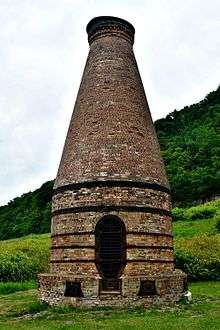
- PFC Melvin Earl Newlin Memorial. PFC Newlin was awarded the Congressional Medal of Honor.
- Bottle Kiln. This Bottle Kiln is located at the corner of 3rd Street and Lisbon Street, and is 41.5 feet high. The Kiln is maintained by the Wellsville Historical Society.
- The Boy and the Boot statue.
- Fulton & Sons Bell: Located at the Free & Accepted Masons of Ohio Lodge on Main Street
- Flood Wall with Murals.
- Honor Roll Wall. This wall pays tribute to every Wellsville resident who served their country in the armed forces. At present there are more than 2,200 names on the wall.
- Episcopal Church of the Ascension and Manse, which is on the National Register of Historic Places.
- The River Museum
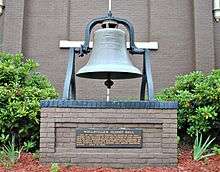
Geography
Wellsville is located at 40°36′15″N 80°39′8″W (40.604168, -80.652207).[12]
The elevation is 682 feet above sea level.
It is located on the Allegheny Plateau. Its southern border is the Ohio River. On its eastern border is the Little Yellow Creek and on its western border is the Yellow Cheek. Its northern border is rising hills.
According to the United States Census Bureau, the village has a total area of 1.91 square miles (4.95 km2), of which 1.80 square miles (4.66 km2) is land and 0.11 square miles (0.28 km2) is water.[13]
Demographics
| Historical population | |||
|---|---|---|---|
| Census | Pop. | %± | |
| 1830 | 169 | — | |
| 1840 | 759 | 349.1% | |
| 1850 | 1,546 | 103.7% | |
| 1860 | 1,587 | 2.7% | |
| 1870 | 2,313 | 45.7% | |
| 1880 | 3,377 | 46.0% | |
| 1890 | 5,247 | 55.4% | |
| 1900 | 6,146 | 17.1% | |
| 1910 | 7,769 | 26.4% | |
| 1920 | 8,849 | 13.9% | |
| 1930 | 7,956 | −10.1% | |
| 1940 | 7,672 | −3.6% | |
| 1950 | 7,854 | 2.4% | |
| 1960 | 7,117 | −9.4% | |
| 1970 | 5,891 | −17.2% | |
| 1980 | 5,095 | −13.5% | |
| 1990 | 4,532 | −11.1% | |
| 2000 | 4,133 | −8.8% | |
| 2010 | 3,541 | −14.3% | |
| Est. 2019 | 3,306 | [4] | −6.6% |
| U.S. Decennial Census[14] | |||
2010 census
As of the census[3] of 2010, there were 3,541 people, 1,475 households, and 957 families residing in the village. The population density was 1,967.2 inhabitants per square mile (759.5/km2). There were 1,774 housing units at an average density of 985.6 per square mile (380.5/km2). The racial makeup of the village was 89.3% White, 6.8% African American, 0.1% Native American, 0.4% Asian, 0.5% from other races, and 3.0% from two or more races. Hispanic or Latino of any race were 1.2% of the population.
There were 1,475 households, of which 34.6% had children under the age of 18 living with them, 36.0% were married couples living together, 22.5% had a female householder with no husband present, 6.4% had a male householder with no wife present, and 35.1% were non-families. 30.8% of all households were made up of individuals, and 12.6% had someone living alone who was 65 years of age or older. The average household size was 2.40 and the average family size was 2.96.
The median age in the village was 37.6 years. 26% of residents were under the age of 18; 8.3% were between the ages of 18 and 24; 24.3% were from 25 to 44; 26.5% were from 45 to 64; and 14.8% were 65 years of age or older. The gender makeup of the village was 46.9% male and 53.1% female.
2000 census
As of the census[15] of 2000, there were 4,133 people, 1,696 households, and 1,107 families residing in the village. The population density was 2,348.4 people per square mile (906.7/km2). There were 1,869 housing units at an average density of 1,062.0 per square mile (410.0/km2). The racial makeup of the village was 90.59% White, 6.97% African American, 0.12% Native American, 0.12% Asian, 0.02% Pacific Islander, 0.05% from other races, and 2.13% from two or more races. Hispanic or Latino of any race were 0.39% of the population.
There were 1,696 households, out of which 31.4% had children under the age of 18 living with them, 42.0% were married couples living together, 19.0% had a female householder with no husband present, and 34.7% were non-families. 30.2% of all households were made up of individuals, and 15.6% had someone living alone who was 65 years of age or older. The average household size was 2.43 and the average family size was 3.02.
In the village, the population was spread out, with 26.3% under the age of 18, 9.5% from 18 to 24, 26.9% from 25 to 44, 21.4% from 45 to 64, and 16.0% who were 65 years of age or older. The median age was 37 years. For every 100 females, there were 86.9 males. For every 100 females age 18 and over, there were 80.8 males.
The median income for a household in the village was $26,198, and the median income for a family was $33,245. Males had a median income of $26,724 versus $19,904 for females. The per capita income for the village was $14,335. About 16.5% of families and 17.1% of the population were below the poverty line, including 23.3% of those under age 18 and 12.1% of those age 65 or over.
Education
Wellsville is served by the Wellsville Local School District.[16] The district operates three schools in the village:
- Wellsville Junior/Senior High School, grades 8-12
- Daw Elementary School, grades K-7
- Garfield Elementary School, grades K-3
Wellsville is also served by the Wellsville Carnegie Public Library. It was established on February 15, 1912. In 2005, the library loaned more than 55,000 items to its 8,000 cardholders. Total holdings as of 2005 are over 36,000 volumes with over 62 periodical subscriptions.[17]
Notable people
- Mary Bowermaster, American record holder in World Masters Athletics Championships
- Tom Casey, Canadian Football League player, led league in rushing yards from 1950 to 1956
- Bevo Francis, NCAA basketball player
- Wallace Samuel Gourley, Federal judge of the United States District Court for the Western District of Pennsylvania
- William Peters Hepburn, U.S. Representative from Iowa's 8th District
- Burr McIntosh, Lecturer, photographer, film studio owner, silent film actor, author, publisher of Burr McIntosh Monthly
- Melvin E. Newlin, United States Marine and Medal of Honor recipient
- Clete Patterson, NFL player
- William Chapman Ralston, San Francisco businessman and financier, founder of Bank of California
- James William Reilly, Ohio state representative, general in Union Army during American Civil War
- P. Craig Russell, comic book illustrator
- Paul Travis, artist
References
- "2019 General Election Results for Columbiana County". Retrieved December 19, 2019.
- "2019 U.S. Gazetteer Files". United States Census Bureau. Retrieved July 28, 2020.
- "U.S. Census website". United States Census Bureau. Retrieved 2013-01-06.
- "Population and Housing Unit Estimates". Retrieved May 21, 2020.
- "Wellsville Demographics - Get Current Census Data for Wellsville, OH". Retrieved November 28, 2016.
- "DanielBooneTrail.com". DanielBooneTrail.com. Retrieved December 23, 2017.
- Mangus, Michael; Herman, Jennifer L. (2008). Ohio Encyclopedia. North American Book Dist LLC. p. 572. ISBN 978-1-878592-68-2.
- From Hale Farm's website: Though Wheatfield Village never really existed, the historic buildings are original 19th century structures built within Ohio's Western Reserve. These buildings were acquired by Hale Farm and moved to the site as part of a "historic preservation through relocation" program. 404 - File or directory not found.
- Davidson, Edgar. Before the Memory Fades. The Wellsville Historical Society (n.d.).
- McCord, William B. (1905). History of Columbiana County, Ohio and Representative Citizens. Biographical Publishing Company. pp. 342.
- "Collected Works of Abraham Lincoln. Volume 4". quod.lib.UMich.edu. Retrieved December 23, 2017.
- "US Gazetteer files: 2010, 2000, and 1990". United States Census Bureau. 2011-02-12. Retrieved 2011-04-23.
- "US Gazetteer files 2010". United States Census Bureau. Retrieved 2013-01-06.
- "Census of Population and Housing". Census.gov. Retrieved June 4, 2015.
- "U.S. Census website". United States Census Bureau. Retrieved 2008-01-31.
- Schools, Wellsville Local. "Wellsville Local Schools". www.Wellsville.k12.oh.us. Retrieved December 23, 2017.
- "2005 Ohio Public Library Statistics:Statistics by County and Town". State Library of Ohio. Archived from the original on 2006-09-24. Retrieved November 10, 2006.
Further reading
- History of Wellsville, OH by Frank L. Wells From: History of Columbiana County, Ohio by Harold B. Barth The Historical Publishing Company Topeka-Indianapolis, 1926
- Before The Memory Fades 1795 - 1950 by Edgar Stanton Davidson Hardcover, 72 pages Publisher: The Wellsville Historical Society:1003 Riverside Avenue, Wellsville, OH(330) 532-1018
